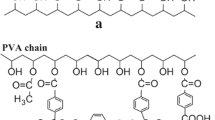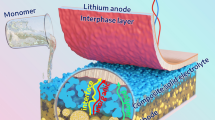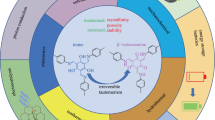Abstract
An oxetane-derived monomer, 3-acryloyloxy-methyl-3′-methyloxetane (AMO) was prepared from the reaction of 3-hydromethyl-3-methyloxetane with acryloyl chloride. The cationic ring-opening copolymerization of AMO with another oxetane-derived monomer, 3-(2-(2-(2-methoxyethylenoxy)ethylenoxy)ethylenoxy)-3′-methyloxetane (MEMO) was conducted in CH2Cl2 solution using BF3 · OEt2/1,4-butanediol as a co-initiator. The resulting copolymers were characterized by FTIR, 1H NMR and Gel Permeation Chromatography (GPC) analyses, and it was found that the enchained ratio of AMO in the copolymers is far lower than its feed ratio. They were crosslinked in situ via the radical polymerization of the vinyl group initiated by BPO after doping with lithium trifluoromethanesulfonimide (LiTFSI) to give rise to tough polymeric electrolyte films. The ionic conductivity was measured at varying content of AMO and different concentration of lithium salt LiTFSI by AC impedance, and a maximum ion conductivity of 1.44 × 10−5 S/cm at 30°C or 1.25 × 10−4 S/cm at 80°C was attained in the sample PAM 33 at the mole ratio of O: Li = 20. The DSC results indicated that T g decreases with the increase of the proportion of AMO in the copolymer, well consistent with the ion conductivity trend. The TGA (thermogravimetric analysis) measurement revealed that this kind of copolymer electrolytes is more thermostable than their liquid counterparts.
Similar content being viewed by others
References
Ganthier M, Armand M B. Assessment of polymer-electrolyte batteries for EV and ambient temperature application. J Electrochem Soc, 1985, 132: 1333–1338
Sequeira C A C, Hooper A. Electrical breakdown phenomena in (PEO)xLiCF3SO3. J Power Sources, 1992, 40: 271–282
Munshi M Z A. Handbook of Solid State Batteries and Capacitors. Singapore: World Scientific, 1995: 45–48
Kalhammer F R. Polymer electrolytes and the electric vehicle. Solid State Ionics, 2000, 135: 315–323
Ye L, Gao P, Feng Z G, Wu F, Chen S, Wang G Q. Conductivity of comb polyether pure solid polymer electrolyte. Electrochemistry, 2006, 12(1): 29–34 (in Chinese)
Sato T, Oki T, Seno T, Hirano T. Radical and cationic polymerizations of 3-ethyl-3-methacryloxymethyloxetane. J Polym Sci. Part A Polym Chem, 2001, 39: 1269–1279
Miwa Y, Tsutsumi H, Oishi T. Novel polymer electrolytes based on mono-and bis-oxetane monomers with oligo (ethylene oxide). Units Electrochemistry, 2002, 70(4): 264–269
Ye L, Feng Z G, Su Y I, Wu F, Chen S, Wang G Q. Synthesis and characterization of homo-and copolvmers of 3-(2-cyano ethoxyl)methyl-and 3-[methoxy(triethylenoxy)] methyl-3′-methyloxetane. Polym Int, 2005, 54: 1440–1448
Ye L, Gao P, Feng Z G, Wu F, Chen S, Wang G Q. Cationic ring-opening polymerization of substituted oxetane monomers. Journal of Functional Polymers, 2005, 18(4): 651–659 (in Chinese)
Bednarek M, Pencze S K, Kubisa P. Polymerization of hydroxy-methyloxetanes synthesis of branched polyethers with primary hydroxyl groups. Macromol Symp, 2002, 177: 155–161
Magnusson H, Malmtrom E, Hult A. Influence of reaction conditions on degree of branching in hyperbranched aliphatic polyethers from 3-ethyl-3-(hydroxylmethyl) oxetane. Macromol, 2001, 34: 5786–5791
Hou J, Yan D Y, Zhu X Y, Fang Y P. Cationic ring-opening polymerization of 3-methyl-3-oxetanemethanol. Chemical Journal of Chinese Universities, 1999, 20(11): 1815–1816 (in Chinese)
Ye L, Feng Z G, Zhang X W, Qin Q, Bai Y, Wu F, Chen S Wang G Q. Synthesis and application as polymer electrolyte of homo-and 3-[methoxy(triethylenoxy)]methyl-3′-methyloxetane. Chinese J Polym Sci, 2006, 24(5): 503–513
Author information
Authors and Affiliations
Corresponding author
Additional information
__________
Translated from Transactions of Beijing Institute of Technology, 2006, 26(12): 1098–1103 [译自: 北京理工大学学报]
Rights and permissions
About this article
Cite this article
Ye, L., Zhao, Y., Feng, Z. et al. Synthesis of copolymers of 3-acryloyloxymethyl-3′-methyloxetane and 3-(2-(2-(2-methoxyethylenoxy)ethylenoxy)ethylenoxy)-3′-methyloxetane and their ionic conductivity properties. Front. Chem. Eng. China 1, 343–348 (2007). https://doi.org/10.1007/s11705-007-0062-0
Issue Date:
DOI: https://doi.org/10.1007/s11705-007-0062-0




